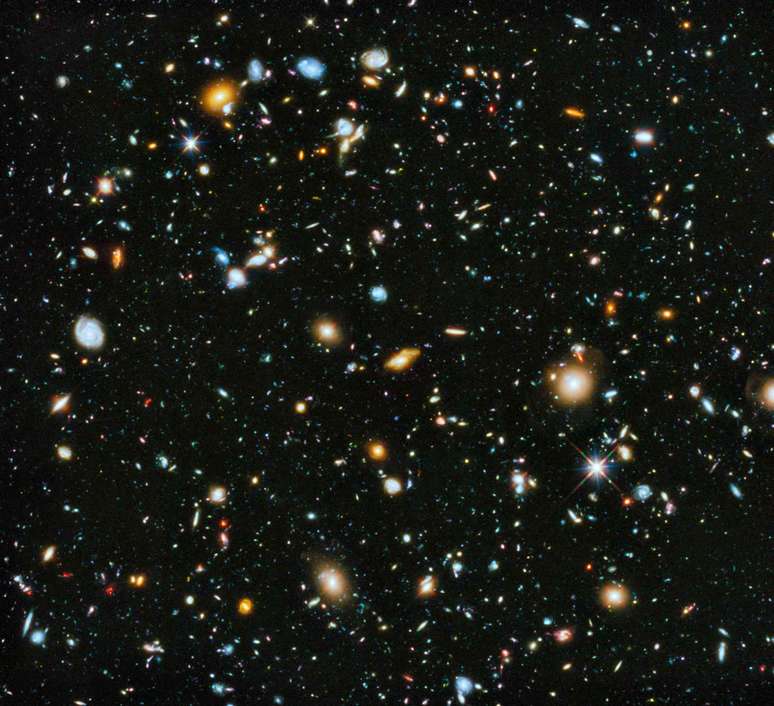Presented by astronomer Carl Sagan, the work manifests a poetic and spiritualist vision of science and has influenced generations of scientists in various fields
In April 2023, astronomer and astrophysicist Makenzie Lystrup became the first woman to lead the Goddard Space Flight Center, one of NASA’s major research centers. This fact, in itself, may be enough for astrophysicists to be seen as making history in their area of expertise. But one detail attracted attention: during the installation ceremony, during the traditional oath, Lystrup used, instead of the Bible, the book “Pale blue dot“, by astronomer and science communicator Carl Sagan. In the United States it is customary for people to take an oath with their hands on symbolic works, such as the Bible (the most common), the Koran or the Constitution. But that was the first time, at least of note, that a book by Sagan was used.
Lystrup explained that the homage to Sagan was due to the television series Cosmoswhich served to reawaken his passion for astronomy and the importance of Sagan as someone who strove to make science accessible to the public. The details of the quote Cosmos This is perhaps what explains the certain religious connotation of the ceremony which involves Sagan’s book as a substitute for the Bible. Like the “Sagan Day“On November 9, which takes advantage of his birthday to remember the legacy of the science communicator, we will revisit this work which manifests a poetic and spiritualist vision of science and has influenced generations of scientists from various fields.
Debut in 1980
Cosmos: a personal journey premiered on American TV on September 28, 1980, 45 years ago. In Brazil the series will be broadcast for the first time on Globo only between August and November 1982. The first sentence uttered by Sagan, at the beginning of the first episode, is: “The Cosmos is everything that exists, that has ever existed and that will always exist”. The idea of eternity, of something that transcends time, is similar to the notion of God coined by some of the world’s major religions, such as Christianity itself.
Thus, through poetic and emotional language, Sagan, over the course of the series’ 13 episodes, displaced the transcendence and spirituality characteristic of religions and repositioned them in the scientific enterprise. An ingenious discursive tactic, which aims to explain how science works, rather than simply showing its discoveries. And which, paradoxically, exalts reason through emotion, through a poetic narrative. A reenchantment of the world through science
This tactic worked. It is estimated that Cosmos it was broadcast in 60 countries and viewed by more than 500 million people. The series was considered a milestone in global scientific dissemination for the great popularity it achieved by translating complex concepts in a way that was understandable to the public, and for having influenced generations of scientists. Among these, Makenzie Lystrup herself. It is, without a doubt, one of the most successful scientific dissemination experiences of the 20th century among a large television audience.
Spiritualist vision of science
As a good scientific communicator, Carl Sagan used everyday elements, familiar to the general public, to introduce concepts and present scientific results. Religions and beliefs in general constituted a significant part of these elements. In the series he sometimes compares religious and mystical explanations with scientific explanations, mainly using narrative conflict to give movement to the sequences; sometimes it emulated religious discourse, creating a certain shift in meaning, as mentioned.
Cosmos is an icon of Sagan’s spiritualist vision of science. This vision can be better understood when we study his other works, such as the book “The world haunted by demons“]in which he states:
“Spirit comes from the Latin word meaning ‘to breathe.’ light years and across centuries, when we understand the complexity, beauty and subtlety of life, then the sublime feeling, mixed with joy and humility, is certainly spiritual. Just as our emotions when faced with great art, music or literature, or acts of exemplary selfless courage such as those of Mahatma Gandhi or Martin Luther King, are spiritual.
The full title of the book – “The world haunted by demons: science seen as a candle in the darkness” – demonstrates another characteristic of Sagan that distinguishes the series Cosmos: a certain Enlightenment perspective on science and history. In many episodes of the series there is a polarization between the Middle Ages and the Modern Age. Sagan identifies the rise of science in ancient Greece, with the destruction of the Library of Alexandria as the turning point for the beginning of the decline. The medieval period, in turn, represents this decline: a long pause in scientific thought and development, caused by the authoritarianism of religion and mysticism. It thus reproduces the Enlightenment narrative, which presented itself as light in contrast to the Middle Ages (the Middle Ages).
This narrative regarding the Middle Ages as a dark period, however, began to be significantly questioned in the second half of the 20th century. The work of historians such as Jacques Le Goff highlights that the period also saw many cultural, religious, social and intellectual advances.
Continuations into the 21st century

Astrophysicist Neil deGrasse Tyson with Sagan’s widow, Ann Druyan, and executive producer Seth MacFarlane in 2014 during the launch event for the first of the sequels to the original series, ‘Cosmos: a space-time odyssey‘
Invision/AP
Cosmos would receive a continuation in 2014. This time, the series would be hosted by astrophysicist Neil deGrasse Tyson. This second version – “Cosmos: a space-time odyssey” -, like the first, consists of 13 episodes. Due to the mythology of the original series, which grew over the course of 34 years, the new version was broadcast on the NatGeo channel in its debut in 170 countries, and preceded by a video of the then American president Barack Obama. In it, Obama spoke of the spirit of “dreaming big”, “of discovery” that Sagan had summarized in the original version.
THE Cosmos by Tyson – a former student of Sagan and also a well-known science communicator – broke the record for the largest global launch in the history of television. This continuation was written again by the researcher and popularizer Ann Druyan, Sagan’s widow, and the physicist Steven Soter, both co-authors of the original version, together with Sagan.
It is not for nothing that the American president himself, when presenting the launch of the series, reveals the weight of the work for the culture of that country. It is worth mentioning that the book “Cosmos“, written by Sagan and which inspired the TV series, was included by the Library of Congress in the list of 88 books that shaped the United States (“88 Books That Shaped America“, 2012). In the same list there are works such as “The path to wealth“, by Benjamin Franklin; “Pragmatism“, by William James; and “The Wizard of Oz“, by L. Frank Baum.
Neil deGrasse Tyson would also present the third season of the series”,Cosmos: possible worlds“. Published in 2020 also by NatGeo, it was broadcast in 172 countries, in 43 languages. Written, directed and produced by Ann Druyan and Brannon Braga, “Cosmos: possible worlds” also featured executive producers Seth MacFarlane (creator of Family Guyanimation better known in Brazil as “A family guy“) and Jason Clark.
Like the previous versions, this third season also has 13 episodes and has maintained a narrative format very similar to those of 2014 and 1980, with the exception of technological advances in the audiovisual field over four decades. The dualities involving science and religion have become less constant in the 2020 season than in previous seasons. However, it remains a narrative rich in history and philosophy that values the dissemination of scientific thought and makes a humanist appeal to use reason to preserve the planet and ourselves.

Alexandre Freitas Campos does not consult, work for, own shares in or receive funding from any company or organization that could benefit from the publication of this article and has not disclosed any relevant connections beyond his academic position.
Source: Terra
Rose James is a Gossipify movie and series reviewer known for her in-depth analysis and unique perspective on the latest releases. With a background in film studies, she provides engaging and informative reviews, and keeps readers up to date with industry trends and emerging talents.







-ubrgialfr7sh.jpg)
